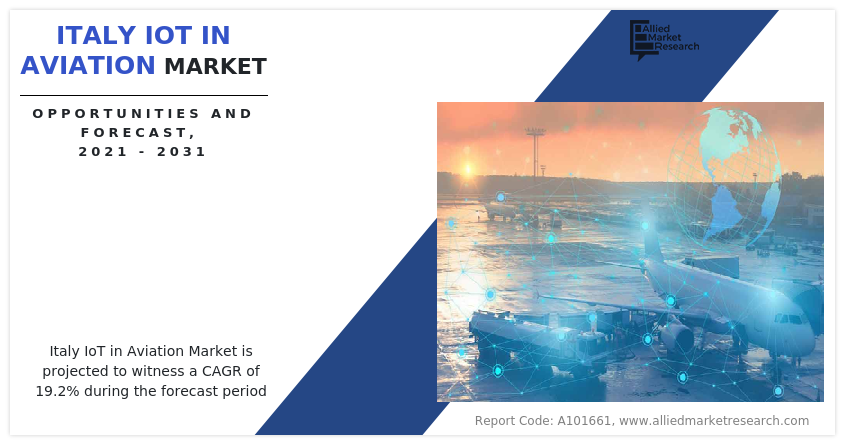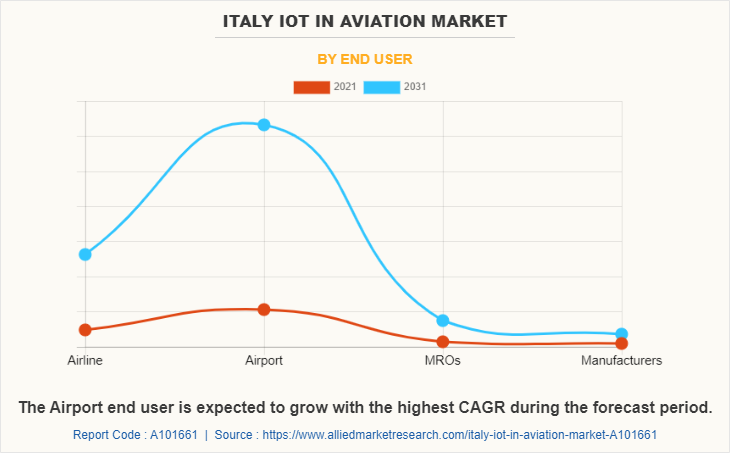The Italy IoT in aviation market is expected to witness considerable growth during the forecast period. This is attributed due to the relentless pursuit of efficiency. In addition, the airline industries are adopting IoT technologies to streamline their operations, reduce costs, and enhance safety which fuels the growth of the market. Furthermore, the upsurge in the passenger demands and expectations for a seamless and personalized travel experience have spurred the adoption of IoT in aviation industry which contribute toward the growth of the market.
However, concerns regarding data security and privacy of sensitive information restrain the market growth. In addition, integrating IoT into these existing systems can be a complex and costly endeavor which hinders the growth of the market.

On the other hand, the Italy IoT in aviation market is brimming with opportunities and future trends. The technological advancements for new and innovative applications for IoT in aviation are emerging. For instance, ground operations are increasingly being optimized through the use of IoT sensors and devices. This includes baggage handling, maintenance scheduling, and runway management, all of which can benefit from real-time data analysis and predictive maintenance. In addition, passenger experience where IoT offers passengers a highly personalized journey, from the moment they book their ticket to the time they disembark provides lucrative opportunities for the growth of the market. Furthermore, IoT-enabled real-time tracking and monitoring of aircraft and their components ensure that maintenance is performed precisely, reducing downtime and enhancing safety offers remunerative opportunities for the growth of the market. In addition, IoT-enabled air traffic management helps to optimize air traffic, reduce delays, and enhance safety by providing real-time data on aircraft positions and conditions. Moreover, stringent government regulations pertaining to the use of IoT in aviation to ensure the safety and security of operations offer new avenues for the growth of the market.
By Component
The Hardware component is expected to grow with the highest CAGR during the forecast period.
The Italy IoT in aviation market is segmented into component, end user, and application. On the basis of component, the market is fragmented into hardware, software, and services. By end user, the market is categorized into airline, airport, MRO, and manufacturers. Depending upon application, the market is classified into ground operations, passenger experience, asset management, and air traffic management.

Qualitative insights represent about remarkable developments in the Italy IoT in aviation market. These insights encompass new product development, research and development efforts, consumer/end-user perceptions, and pricing strategies. Companies are focusing on new product development and R&D to create new and innovative solutions for the aviation industry. Understanding consumer and end-user perceptions is crucial as passengers, airlines, and other stakeholders need to be convinced of the benefits and safety of these technologies. Companies are exploring flexible pricing models to make the technology accessible and appealing to a broad range of aviation players.

The Porter’s five forces analysis is a model, which analyzes the competitive scenario of the industry and role of each stakeholder. The five forces include the bargaining power of buyers, the bargaining power of suppliers, the threat of new entrants, the threat of substitutes, and the level of competitive rivalry. The threat of new entrants is relatively high due to the rapid technological advancements and the potential for disruptive innovations. Existing players need to continually invest in R&D and stay agile to maintain their competitive edge. The bargaining power of suppliers is substantial as the aviation industry relies heavily on IoT solutions; these providers have a strong position in negotiations. However, they also face the pressure of delivering secure and reliable systems, which can limit their power. The bargaining power of buyers, comprising airlines, airports, MROs, and manufacturers, varies based on their size and influence. Larger players may have more negotiating power, while smaller organizations may have limited options. The threat of substitutes is relatively low as IoT in aviation offers unparalleled advantages in terms of data collection, analysis, and automation. The intensity of competitive rivalry is high due to the presence of multitude of companies offering IoT solutions in the aviation market.
A SWOT analysis provides an overview of the Italy IoT in aviation market. It includes its internal strength, weakness, opportunities and threats. The strengths of this market lie in its ability to significantly enhance efficiency, safety, and passenger experience. IoT technologies offer real-time data and automation, reducing operational costs and enhancing safety. The main weakness is the high initial investment required for IoT implementation. In addition, the integration of IoT with legacy systems can be a complex and costly process, hindering adoption. The opportunities abound in the IoT in aviation market lies with a vast potential for innovation and new applications. The primary threats are cybersecurity concerns and data privacy issues.
The key players operating in the Italy IoT in aviation market are Leonardo S.p.A., Thales Group, Honeywell International Inc., General Electric Company, IBM Corporation, Rockwell Collins, Inc., SITA, Siemens AG, SAP SE, and Lufthansa Systems.
Key Benefits For Stakeholders
- Enable informed decision-making process and offer market analysis based on current market situation and estimated future trends.
- Analyze the key strategies adopted by major market players in Italy IoT in the aviation market.
- Assess and rank the top factors that are expected to affect the growth of Italy IoT in the aviation market.
- Top Player positioning provides a clear understanding of the present position of market players.
- Detailed analysis of the Italy IoT in the aviation market segmentation assists to determine the prevailing market opportunities.
- Identify key investment pockets for various offerings in the market.
Italy IoT in Aviation Market Report Highlights
| Aspects | Details |
| Forecast period | 2021 - 2031 |
| Report Pages | 83 |
| By Component |
|
| By End User |
|
| By Application |
|
| Key Market Players | Senovo, L3 Technologies, Thales Group, Avio S.p.A., Honeywell Aerospace, Com An S.p.A, Comer Industries S.p.A., ADB Airfield Solutions Italia S.p.A., Simoco, GE Aviation |
The Italy IoT in Aviation Market is projected to grow at a CAGR of 19.2% from 2021 to 2031
Com An S.p.A, ADB Airfield Solutions Italia S.p.A., Simoco, Comer Industries S.p.A., Honeywell Aerospace, GE Aviation, Avio S.p.A., L3 Technologies, Senovo, Thales Group are the leading players in Italy IoT in Aviation Market
1. Enable informed decision-making process and offer market analysis based on current market situation and estimated future trends.
2. Analyze the key strategies adopted by major market players in italy iot in aviation market.
3. Assess and rank the top factors that are expected to affect the growth of italy iot in aviation market.
4. Top Player positioning provides a clear understanding of the present position of market players.
5. Detailed analysis of the italy iot in aviation market segmentation assists to determine the prevailing market opportunities.
6. Identify key investment pockets for various offerings in the market.
Italy IoT in Aviation Market is classified as by component, by end user, by application
Loading Table Of Content...
Loading Research Methodology...



